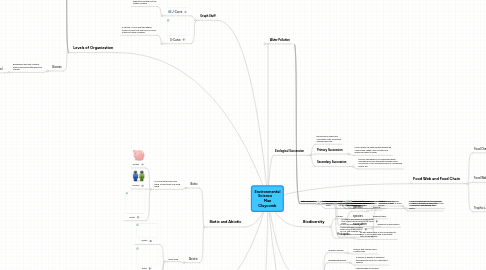
1. Biotic and Abiotic
1.1. Biotic
1.1.1. is a living thing, was a livin thing, or was a part of a living thing
1.1.1.1. animals
1.1.1.2. humans
1.1.1.3. plants
1.2. Abiotic
1.2.1. never living
1.2.1.1. metals
1.2.1.2. water
1.2.1.3. air
2. Levels of Organization
2.1. Organism
2.1.1. a living thing
2.2. Population
2.2.1. a group of the same species living together
2.3. Community
2.3.1. different types of organisms that live together and interact
2.4. Ecosystem
2.4.1. habitat where different organisms survve and interact
2.5. Biomes
2.5.1. geographic area that contains many ecosystems determined by climate
2.5.1.1. EXAMPLES least to greatest(biodiverse wise)
2.5.1.1.1. Tundra
2.5.1.1.2. Desert
2.5.1.1.3. Freshwater
2.5.1.1.4. Grassland
2.5.1.1.5. Coniferous Forest
2.5.1.1.6. Temperate Deciduous
2.5.1.1.7. Marine
2.5.1.1.8. Rainforest
3. Population Stuff
3.1. Limiting factors
3.1.1. Conditions of the environment that limit the growth of a population.(Biotic and Abiotic factors)
3.2. Carrying Capacity
3.2.1. Is the number of individuals of a species that an ecosystem can support
3.3. Population Growth
3.3.1. The total amount of the species that inhabit the area
3.4. Population Growth Rate
3.4.1. The rate at which the species is growing, can be positive and negative
4. Graph Stuff
4.1. J-Curve
4.1.1. Exponetial Growth is at the sudden increase
4.2. S-Curve
4.2.1. Is like the J-Curve but then begins tolevel off over time and has NO POINT at which it stops increaing
5. Extra Stuff
5.1. urbanization
5.1.1. the physical growth of urban areas as a result of global change
6. Biodiversity
6.1. 3 types
6.1.1. genetic
6.1.1.1. make up
6.1.2. species
6.1.2.1. different types
6.1.3. ecosystem
6.1.3.1. difference in ecosystems
6.2. Hot spots
6.2.1. an area where there is lots of biodiversity. Only 17 left on earth and all are pretty close to the equator.
7. Food Web and Food Chain
7.1. Food Chain
7.1.1. arrows showing transfer of E
7.2. Food Web
7.2.1. shows the connections between food chains better an descirbes a ecosystem.
7.3. Trophic Levels
7.3.1. Producer
7.3.1.1. Gets 100% of the energy
7.3.2. Primary Consumer
7.3.2.1. Gets 10% of the energy
7.3.3. Secondary Consumer
7.3.3.1. Gets 1% of the energy
7.3.4. Tertiary Consumer
7.3.4.1. Gets .1% of the energy
7.3.5. Decomposer
8. Species
8.1. Indicator species
8.1.1. Species that canonly live in a certain area
8.2. Endangered species
8.2.1. A species in danger of extinction throughtout most or all of the area it inhabits
8.3. Threatened species
8.3.1. A species likely to become endangered in the near future
8.4. Pioneer species
8.4.1. A species that appears early in succession and grows fast, requires few resources, and thrives with little competition.
8.5. Climax Community
8.5.1. Large, grow very slowly, and reproduce quickly an dominate in community. Climax Communitites neverchange unless there is a disturbance.
9. Ecological Succession
9.1. the process in which the community of an ecosystem changes over time
9.2. Primary Succession
9.2.1. occurs where life never existed before like a new island. seeds come to island and slowly life begins to grow.
9.3. Secondary Succession
9.3.1. process that begins in an ecosystem when something occured that destroyed the ntural community. At an abondoned farm or Yellowstone due to fire.
10. Water Pollution
10.1. the contamination of water bodies
10.2. water purification
10.2.1. the process of getting rid of unwanted contaminents from water.
10.2.2. Desalination
10.2.2.1. any processses that remove minerals from water.
10.3. Types of pollution
10.3.1. Point source
10.3.1.1. pollution that comes from one specific area and can be identified.
10.3.2. Non-point source
10.3.2.1. pollution that comes from many areas and cannot be identified
10.3.3. Impermeable
10.3.3.1. not allowing the passage of fluids thrugh a material
10.3.3.1.1. Impermeable surfaces lead to RUNOFF
10.3.4. Organic pollutant
10.3.4.1. contaminents in an environment that can be biodegraded by microorganisms
10.3.5. in-organic pollutant
10.3.5.1. contaminents in an environment that can not be biodegraded by microorganisms
10.4. Water Bodies
10.4.1. Aquifer
10.4.1.1. an undergrounf layer of water bearing permeable rock, from which groundwater can be extracted from.
10.4.2. Watershed
10.4.2.1. an area of land where all of the water that it drains off of goes to the same place
10.4.3. Wetlands
10.4.3.1. an area of land whose soil is saturated with moisture either most of the year or all of it, and a habitat for certain types of animals.
10.4.3.1.1. when wetlands are destroyed, it leads to more erosion
11. Resources
11.1. natural resouces
11.1.1. materials that can be found on earth
11.2. renewable resources
11.2.1. a material that can be used and replaced before the end of the human life span
11.3. non renewabe resources
11.3.1. a material that cannot be replaced before the end of a human life span
